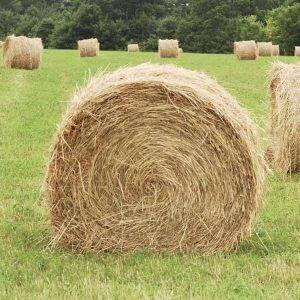
Kentucky Performance Products: Picking Hay for Sugar/Starch Sensitive Horses
All horses need fiber in their diet and some of it must be the form of long hay. Horses challenged by metabolic syndrome should be offered hays that are low in non-structural carbohydrates or NSC. This class of carbohydrates includes starch, water-soluble sugar, and fructan.
Normal horses can tolerate NSC levels of 20% or higher. It is recommended that horses with metabolic syndrome consume hay with NSC levels of around 10% to 12%.
In order to know the true NSC value of your hay you will have to test it, but understanding the factors that affect NSC levels will help you pick a hay that is more likely to meet your horse’s needs. Several factors affect the NSC levels found in a cutting of hay. Multiple cuttings from the same field of grass can yield hay with different levels of NSC. The type of plant, maturity when harvested, time of cutting, time spent curing in the field, and environmental conditions during harvest all contribute to the amount of NSC found in the plant. When choosing hay for a starch/sugar sensitive horse, you have to consider all these factors.
Type of plant:
Typical NSC levels in different types of hay*
- Grass hays: average of 12% (range 7%-18%)
- Legume hays (alfalfa and clover): average of 15%
- Oat hay: average of 22%
*Values from Equi-analytical Laboratories.
Maturity of plant
- Young plants tend to be higher in sugar
- Mid-bloom, mature grass tends to be lower in sugar
- Very mature plants tend to contain large amounts of indigestible fiber and can be unpalatable
Timing of harvest and curing conditions
- Grasses harvested in the morning, following evenings when temperatures are 40°F or above will be lower in NSC
- The longer hay is dried in the field, the lower the NSC
- Western hays tend to be harvested later in the day and baled more quickly than Eastern hays, so they can be higher in NSC
- Hay that has been lightly rained on will be lower in NSC; however, it must be completely dry when baled or it will become moldy
Environmental conditions at harvest time
- Grasses stressed from drought conditions or freezing temps will contain higher percentages of NSC
- Stressed warm season grasses, such as crabgrass or coastal Bermuda grass, tend to be lower in NSC
- Stressed cool season grasses, such as fescue, orchard grass, and timothy, tend to be higher in NSC
Hay analysis
The best way to determine the NSC value in a bale of hay is get it tested. When you test your hay you get not only the NSC value but other nutrient levels as well. There are several laboratories that specialize in hay analysis. Equi-analytical Laboratories has a 6-step procedure in diagram form on their website. You can also check with your local extension office to see if they offer testing services.
Plan on collecting a sample for each load of hay you purchase. To collect your sample you will need a hay probe, a drill, and a zip lock sealable plastic bag to put the sample in. You can either purchase a hay probe or you can check with your local extension office to see if they can loan you one.
To sample your hay, pick 12 to 20 random bales from throughout the load. Probe each bale in the center of the strings on the small end of the bale so you are probing the length of the bale. Put each sample in the bag and mix well. Fill out the paperwork required by the testing facility and drop it in the mail. Once you receive your results, if you have any problems understanding them don’t hesitate to contact the lab or your local extension office for help.
At some point, most of us will have to manage a starch/sugar sensitive horse. Understanding the need to tailor a diet to meet his or her needs will make your life easier and your horse happier.
About Kentucky Performance Products, LLC:
ProbioticWise
Need to sustain a healthy hindgut?
Ask your vet about ProbioticWise™.
ProbioticWise:
For more information, visit KPPvet.com.







Leave a Comment